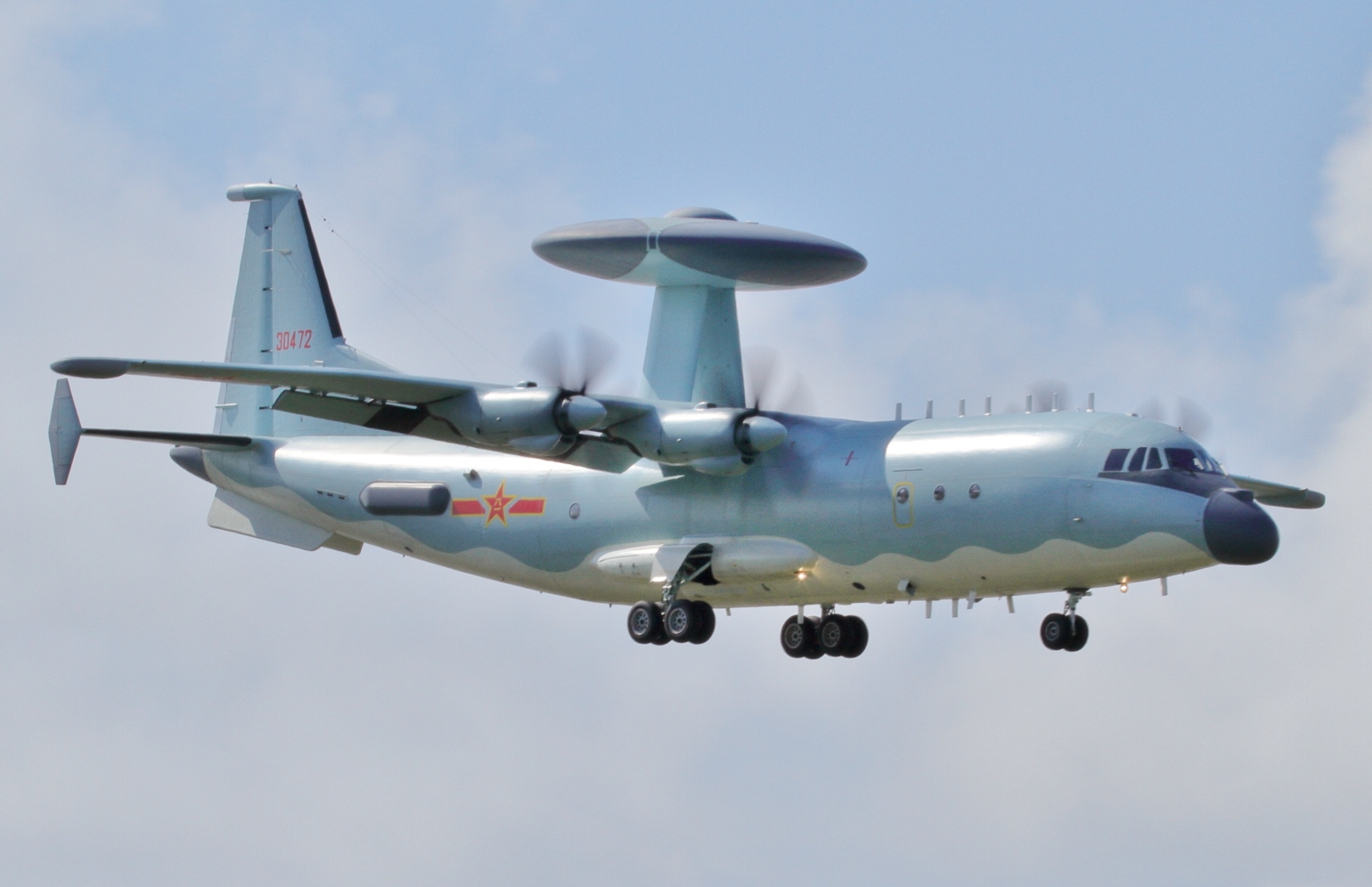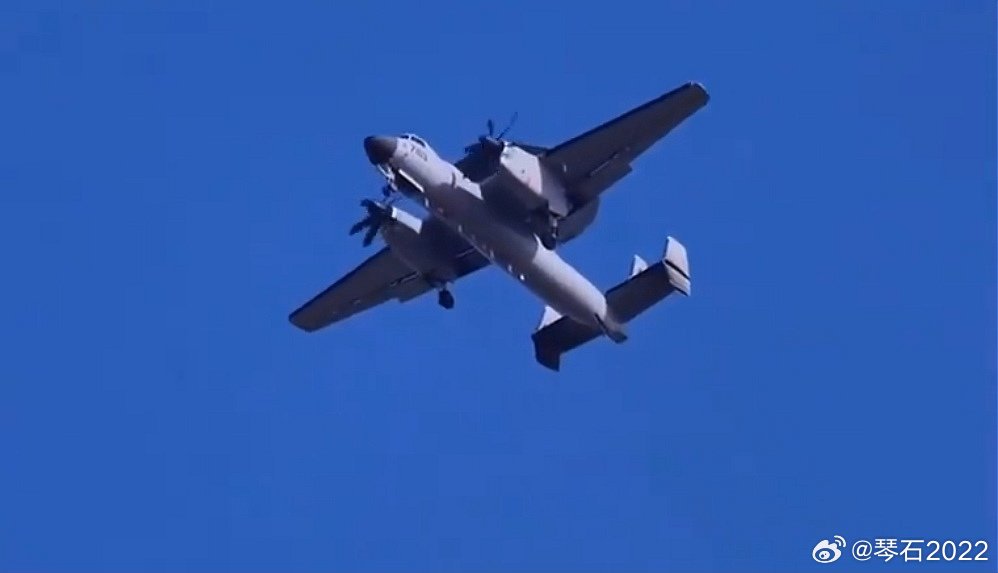Social media has been abuzz with pictures of China’s newest Airborne Warning and Control System (AWACS), the dual-turboprop carrier-borne KJ-600, undergoing tests.
While signifying the People’s Liberation Army Navy’s (PLAN) rapid progress towards being a “blue water” force with the launch of its third aircraft carrier, Fujian, from which it would operate, it is also an addition to the large inventory of diverse airborne early warning (AEW) aircraft.
The massive fleet of AEW&C/AWACS planes denotes peculiar Chinese military thinking. With the demand for redundancy and predominance in radar coverage, the Chinese military maintains the flexibility of its ‘kill chains,’ which contain weapons release and detection platforms.
How China considers kill chains both a vital and vulnerable infrastructure where it aims to strengthen its own and “degrade” or “disrupt” the adversary’s can be read here.)
At a broader level, having a large AWACS fleet fits into the larger Chinese “intelligentized warfare” doctrine. It believes control over the flow of battlefield information would decide the outcome of a war rather than the core combat power.
China’s AWACS Fleet
China has various types of operational AWACS platforms, and Air Marshal Anil Chopra has written extensively about them for the EurAsian Times.
One is the KJ-2000, the largest AEW&C platform, which is an indigenous Type 88 radar mounted on a Russian A-50 Mainstay AWACS by the Xi’an Aircraft Corporation (XAC). Reports also suggest Chinese planners are pursuing the KJ-3000 project. That involves a more modern radar with powerful electronics and processors mounted on the indigenously developed Y-20A transport strategic transport aircraft.
Another operational AWACS platform is the Shaanxi Aircraft Corporation (SAC) Y-8J, based on the Y-8 turboprop transport and used by PLA naval aviation. Developed under Project 515 and first spotted near Shanghai in 2000, it features a British Skymaster surveillance radar housed in a prominent bulbous and partially drooped nose radome.
The Y-8W/KJ-200 is China’s second smallest tactical AEW&C type, after the Y-8J. The KJ-200 is based on the Category III airframe of the Y-8, which has a redesigned fuselage with a solid nose and a new tail section with the loading ramp removed.
The KJ-500, meanwhile, is based on the Y-9 airframe and is used by both the PLA Air Force (PLAAF) and PLA Naval Aviation. The latest addition to its AWACS fleet has been the KJ-600, a twin-turboprop carrier-borne AEW&C plane meant to operate from the Fujian.
The carrier, with its Electromagnetic Launch System (EMALS), can launch and recover heavier aircraft like fixed-wing AWACS/AEW&C. The Shandong and the Liaoning carriers however, which are STOBAR, ski-jump configured, operate rotary-wing helicopter-mounted AWACS/AEW&C platforms.
Airborne Radar Advantages
AEW&C platforms provide a cover-up for the space, depth, and range limitations imposed by the fixed position of powerful ground-based radars. They are mobile and airborne and can fly at different altitudes. This helps them ‘look down’ and spot low-flying missiles, aircraft, or those hidden in the ground radars’ blind spots owing to the earth’s curvature.
An airborne radar can bring this capability to different locations, while many AWACS can cover a wider front, coordinating with other ground-based radars and surface-to-air missiles (SAM) in forming a deeply networked integrated air defense (IAD).
Linking with SAMs of short, medium, and long ranges in overlapping domes of coverage while also directing and alerting air dominance and interceptor jets, AWACS is an integral element in a well-rounded defensive and offensive aerial warfare.

AWACS are a non-combat, support, and surveillance platform. They are, therefore, a part of the broader electronic warfare (EW) realm. Modern AWACS have on-board Electronic Support/Surveillance Measures (ESM), beside the radar emitters/array, to assess and analyze various radio frequency emissions coming to or going from the targets they are tracking. This helps to better identify changing adversary tactics, especially a peer rival with stealth capabilities, and support its fighters and interceptors.
The current war in Ukraine has seen Russia’s success with its A-50U AWACS. It fused with the ultra-long-range S-400 missile to shoot down many Ukrainian Air Force (UAF) jets.
Ironically, the Russian Aerospace Forces (RuAF) also has a limited number of the same AWACS – seven to nine units – after losing three to Ukraine. This exposed a brief tactical vulnerability to air-launched cruise missiles like the Storm Shadow/SCALP-EG and long-range drones.
In India, the lack of AWACS was one of the reasons behind the loss of Wing Commander Abhinandan’s MiG-21 when the Indian Air Force (IAF) and Pakistan Air Force (PAF) jets clashed over the skies of Kashmir in February 2019.
How Chinese See AWACS
A ‘system of systems’, AWACS’s long radar coverage allows them to safely operate from within their territory, beyond enemy missile and fighter ranges. The PLA Air Force views an enemy’s AWACS platform as a key element in the latter’s kill chain, the loss of which would severely ‘blind’ its fighters.
The J-20 itself has been assessed to serve this purpose. Using its stealth, electronic warfare (EW), and jamming capabilities, it can slip past fighter screens and take down vulnerable support assets like AWACS or aerial refueling tankers with long-range BVR missiles like the PL-15.
Naturally, a peer adversary like the US might employ the same strategy. China’s large AWACS fleet, therefore, ensures redundancy. The US, on the other hand, faces a shrinking AWACS fleet. The availability of E-3 Sentry AWACS has been declining due to part shortages. Replacing the older retiring airframes with the new E-7A Wedgetail is taking time.

Amid this backdrop, China evolved from its “informationized war” concept to “intelligentized war.” Here, the primacy of possessing information and an “enhanced situational awareness” can decide the outcome of a battle.
Speaking at a seminar organized by Xinhuanet in early July 2021, Lu Jun, Chief Designer of the KJ-2000, and Cui Jixian, the Deputy Executive Designer of the KJ-500, talked about future airborne warning roles to be distributed between various small and big aircraft and assets. “A future AWACS will likely not be one single aircraft, but a cluster of platforms that can accomplish different missions and build an information network,” they said.
While individual assets like aircraft, submarines, or tanks can deal with their counterparts in war, the key is to integrate all space, aerial, ground, surface, and underwater systems for “joint combat capability.” February 2024 saw satellite pictures of the Anshun Huangguoshu Airport, capturing what appeared to be the Divine Eagle UAV. This was an example of “intelligentized warfare” taking shape.
“These platforms will play their specially designed roles based on the demands of combat missions, with the final goal being winning the war,” Cui said. He added that both large and small AWACS platforms are future trends.
Intelligentized Warfare
A manifestation of this primacy of information sharing is the J-20. Its designer Yang Wei calls the concept of maneuverability “outdated.” In a paper in Chinese military aviation journal, Acta Aeronautica Sinica, in July 2020, Yang Wei gave the most extensive insight into the present Chinese military doctrine that puts situational and all-domain awareness and information processing ahead of the performance of individual combat systems.
“Information has now become the deciding factor, as modern fighter jets focus on gaining more information with the help of AESA (Active Electronically Scanned Array) radars and data chains, while also reducing opponents’ ability to gain information, including using stealth technology and electronic countermeasures. When aircraft can get more information with these advanced devices, pilots must have extensive knowledge, sharp analysis, and sound decision-making to put them to use,” Wei said.
Artificial intelligence, then, will help pilots process the information and enable them to become mission objective-oriented by leveling up the observe-orient-decide-act (OODA, a four-step approach to decision-making) loop to OODA 3.0.
According to Yang, the range, combat endurance, powerful stealth, and heavy payload of air-to-air and air-to-ground missiles and the ability to provide the pilot with “easy-to-understand” battlefield situation images—drawing and transmitting to and from all friendly assets in an “integrated network”—are vital here, too.
A September 2020 study by the US Department of Defense (DoD) acknowledges the PLA’s belief that “intelligentized capabilities” have enabled it to make “rapid and efficient decision-making” to win a war.
“To quickly observe, orient, decide, and act in an increasingly dynamic operating environment…China is pursuing AI to support future capabilities, such as autonomous command and control (C2) systems, sophisticated and predictive operational planning, and intelligence, surveillance, and reconnaissance (ISR) fusion.
“In addition, the PLA is developing…future command, control, communications, computers, intelligence, surveillance, and reconnaissance (C4ISR) systems will seek to use AI to collect, fuse, and transmit big data for more effective battlespace management and to generate optimal courses of action,” the DoD report said.
- The author can be reached at satamp@gmail.com
- Views personal of the author
- Follow EurAsian Times on Google News




